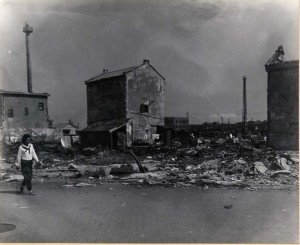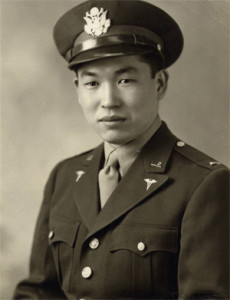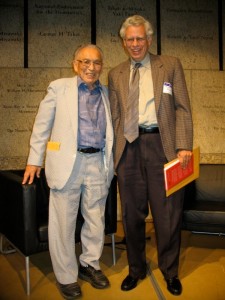
I was chauffering Yamazaki and his wife of 65 years, Aki, to the Japanese American National Museum in downtown Los Angeles. Documentarian Steve Schecter was also in our carpool. Schecter [was] filming a documentary about Yamazaki’s remarkable life and march towards peace.
We were headed for “A Conversation with Dr. James Yamazaki” sponsored by Physicians for Social Responsibility-Los Angeles (PSR-LA) and coordinated by its Associate Director, Denise Duffield, who is also EnviroReporter.com‘s editor and designer.
See a gallery of photographs of the event here.
In 1985, PSR shared the Nobel Peace Prize with International Physicians for the Prevention of Nuclear War, “for spreading authoritative information and by creating an awareness of the catastrophic consequences of atomic warfare.”
PSR-LA awarded Dr. Yamazaki its 2008 Socially Responsible Medicine Award for his life’s work which “helped chart the dangers of nuclear radiation and presents powerful observations of both the medical and social effects of the bomb,” as the back cover of his book reads – “Children of the Atomic Bomb: An American Physician’s Memoir of Nagasaki, Hiroshima, and the Marshall Islands”
Listening to him talk as we drove down Wilshire Boulevard on a picture perfect Los Angeles day, I realized this man had lived more lives than seem possible.
Jim Yamazaki joined the army before Pearl Harbor. When shipping out for Europe, where Japanese-American troops were deemed “safe” to fight, he went to see his parents in a wartime internment camp in Arkansas.
After completing his medical education in Wisconsin, Yamazaki was assigned to the 106th Infantry Division as a Combat Medic (Battalion Surgeon). On December 6, 1944, the “Golden Lion” division landed in France and embarked on the Rhineland Campaign.
Ten days later, the Germans launched a bold strike through the forested Ardennes Mountains region of Belgium, France and Luxembourg on the Western Front. The offensive was called Operation “Watch on the Rhine” by the German armed forces, the Wehrmacht.
With over 800,000 men committed and over 19,000 killed, the Battle of the Bulge became the single biggest and bloodiest battle that American forces fought in World War II. We won that battle but paid a very high price in the process. Jim paid it personally.
Yamazaki was captured by the Germans and then force-marched 800 miles as a prisoner of war. He managed to survive but that wouldn’t surprise you if you know the man.
Yamazaki wasn’t the only Japanese-American fighting in Europe. The 3,800 men of the 442nd Infantry were of Jim’s ancestry and earned the nickname “The Purple Heart Battalion.” The unit fought valiantly across with Italy, southern France, and Germany and became the most highly decorated military unit in the history of the United States Armed Forces. The 442nd alone had 21 Medal of Honor recipients and famously rescued the “Lost Battalion” in the Vosges Mountains in October 1944. These kind of heroics exacted a high price. U.S. Army battle reports show the official casualty rate was 93%. Wounded soldiers reportedly would often escape from hospitals to return to fight in the front line battles.
After the war, at the age of 33, the US government asked Dr. Yamazaki to head the Nagasaki Atomic Bomb Casualty Commission. From 1949 to 1951, he worked with children in Hiroshima, Nagasaki, and with Marshall Islanders who suffered from American postwar nuclear testing. His research focused on the effects of radiation on fetuses, and as his team had predicted, devastating abnormalities were seen in babies who were yet unborn when the bombs hit, and numerous mothers experienced still-births or miscarriages.
Upon his return to the US, Dr. Yamazaki continued his dedicated research on the effects of radiation on children, became a clinical professor of pediatrics at UCLA, and maintained a pediatric practice. He has continued to promote nuclear disarmament and also to follow the effects of nuclear radiation on generations of families in Japan throughout his career.
In partnership with the UCLA Asian American Studies Center, Dr. Yamazaki has established a website ChildrenoftheAtomicBomb.com.
And all this time, this genuine American hero has been married to the love of his life, Aki. Denise’s special affection for this couple is a delight to behold, and Jim and I relate so well that it feels like I’ve known him forever.

A Ph.D. in International Relations from the prestigious Johns Hopkins University’s School for Advanced International Studies, Ramberg is the author of a plethora of books and articles on nuclear issues. Most well-known for his classic treatment of the vulnerability of nuclear power plants to military attack and sabotage – Nuclear Power Plants as Weapons for the Enemy (University of California Press) – Ramberg has been on the faculty at Stanford, Princeton, and UCLA, consulted Congress on foreign policy, and worked in the State Department during the administration of George H.W. Bush. Over the last several years, Dr. Ramberg has become the country’s most published newspaper commentator on nuclear security issues, having authored dozens of Op-Eds in major papers in his attempt to turn the world away from another nuclear arms race.
After greetings and introductions from the museum’s President, Akemi Kikumura Yano, and PSR-LA board member, Dr. Jimmy Hara, Ramberg asked Yamazaki about his life, and the various experiences in the book. Dr. Yamazaki spoke of the human toll of nuclear warfare and the specific vulnerability of children to the effects of these weapons. The men discussed the brutal ironies of racial and cultural conflict, of war and sacrifice, and a portrait of events whose lessons remain difficult and troubling 64 years later.
When Ramberg opened the floor for questions and comments, none were more moving than those by Shigeru Nakayama, an actual survivor of the Hiroshima atomic bombing August 6, 1945. He was 17 at the time. Several physicians asked Yamazaki about the multi-generational effects of the bomb that continue to be discovered. And of course there is the inevitable question about whether or not the Japanese would have surrendered without the atomic bomb. Yamazaki says he doesn’t know – his primary concern is and has always been about the future, to make sure that nuclear weapons are never used again.
When I got to the microphone, I asked Jim where he was when he first heard of the bombing of Hiroshima August 5, 1945.
“I was in Ashville North Carolina with other returning POW’s,” Jim said. Yet even being these returning heroes, Yamazaki and other soldiers of the integrated 106th soldiers had to watch ‘how to be an American patriot’ films.
“The fellow servicemen he was resting in the mountains with were not Japanese-American,” said Schecter. “They were his buddies from his unit. They were being re-indoctrinated because they had been POWs, and the US was afraid they could have been brain-washed.”
When news of the atomic bombings and subsequent Allied victory over Japan were announced, Asheville practically shut itself down.
“They confined us to our rooms,” Dr. Yamazaki said, including the recollection that Asheville shut down all its bars in anticipation of American soldiers going on a rampage. “They thought we were going to tear the place up,” Jim said.
“The ruckus the authorities were afraid of was a celebration over the victory!” Schecter told me later. “Strange world, huh?”
Dr. James Yamazaki is a brave yet peaceful man. He fights so that all of us can never experience the horrors of nuclear war. He also has found the secret to long and loving life with Aki. I think that one reason we get along so well is I know that secret too. That secret is to love fiercely, fight fiercely and put people and planet first.
Gallery of “A Conversation with Dr. James Yamazaki”
Video of of Dr. James Yamazaki in his eyewitness account, compares the human casualties of the Battle of the Bulge (the biggest battle of World War II), with the human casualties of the atomic bombs dropped on Hiroshima and Nagasaki.
Video trailer of the documentary, “Dr. James Yamazaki and the Children of the Atomic Bomb.”












Our dear friend Jim Yamazaki passed March 5, 2021 at his home in Salmon, Washington. Denise and I have been honored to call this man our friend, as well as his wife Aki of 70 years, who passed exactly 7 years earlier on the same date. Let me tell you what real joy is, what real living is. Jim was, and is a hero who fought like a tiger in the Battle of the Bulge in World War II, was captured by the Wehrmacht and marched by Nazis 800 miles across Germany in the freezing winter before finally being freed. The US Army then sent him to Nagasaki to have the young doctor examine Japanese children who had suffered being children of the atomic bomb. That set this pediatrician and activist on a lifelong march towards a world without nuclear weapons. My joy was that this man found me more interesting than himself, when that clearly wasn’t the case. My living was that I could make this Japanese-American man laugh as only an Irish-American can.
My wife and editor of EnviroReporter.com, Denise Duffield, was especially close to Aki and Jim. Her words reflect the love we all reveled in, as expressed in her letter to colleagues informing them of the sad news:
Hi all,
I learned today that our beloved Dr. Jim Yamazaki passed away on March 5, at the age of 104. He died exactly 7 years to the day that his wife Aki died, after 70 years of marriage. Here is an obit, and attached is PDF of obit from LA Times: https://www.legacy.com/obituaries/latimes/obituary.aspx?n=james-nobuo-yamazaki&pid=198106731
Dr. Yamazaki served in WWII as a combat surgeon, visiting his parents in an internment camp before he set off for war. He was captured in the Battle of the Bulge and marched 800 miles as a POW. After the war he served as head of the Atomic Bomb Casualty Commission, studying the effects of radiation on children in Nagasaki and Hiroshima which he continued for decades and chronicled in his book “Children of the Atomic Bomb.” Despite experiencing the horrors of war and cruelty of racism, before and after the war, Jim was eternally positive, full of love and laughter with a wonderful sense of humor. He was also a pediatrician who was much loved by generations in LA especially LA’s Japanese-American community. His obit fills in more details of his extraordinary life. Jim charmed all who met him, including and especially me and my husband who developed an enduring friendship. PSR-LA honored Jim at our 2008 dinner and held numerous events featuring him over the years. He moved to White Salmon WA and was also involved with PSR Oregon and Washington.
Jim Yamazaki was the quintessential physician for social responsibility. He had a tremendous influence on me, personally and professionally. I doubt I’ll ever know a finer human being.
Denise
Wary are we who have to carry on with one less American hero named James Nobuo Yamazaki. Ever grateful am I that Jim Yamazaki called me his friend and loved Denise and I. We are consoled knowing that Jim and Aki know go together now as they always have and always will.
Message from His Holiness Pope Francis, delivered this morning (Dec 8) by Archbishop Silvano Maria Tomasi, Permanent Observer of the Holy See to the United Nations in Geneva. This was part of the opening plenary of the Vienna Humanitarian Impact of Nuclear Weapons Conference. Posted as a pdf to the conf. website.
http://www.bmeia.gv.at/fileadmin/user_upload/Zentrale/Aussenpolitik/Abruestung/HINW14/HINW14_Message_from_His_Holiness_Pope_Francis.pdf
Excerpts for your perusal:
“The humanitarian consequences of nuclear weapons are predictable and planetary.”
“Military codes and international law, among others, have long banned peoples from inflicting unnecessary suffering. If such suffering is banned in the waging of conventional war, then it should all the more be banned in nuclear conflict.”
“Nuclear deterrence and the threat of mutually assured destruction cannot be the basis for an ethic of fraternity and peaceful coexistence among peoples ans states. The youth of today and tomorrow deserve far more.”
“Spending on nuclear weapons squanders the wealth of nations. To prioritize such spending is a mistake and a misallocation of resources which would be far better invested in the areas of integral human development, education, health and the fight against extreme poverty. When these resources are squandered, the poor and the weak living on the margins of society pay the price.”
“‘A world without nuclear weapons” is a goal shared by all nations and echoed by world leaders, as well as the aspiration of millions of men and women. The future and survival of the human family hinges on moving beyond this ideal and ensuring that it becomes a reality.
“I am convinced that the desire for peace and fraternity planted deep in the human heart will bear fruit in concrete ways to ensure that nuclear weapons are banned once and for all, to the benefit of our common home.”
What an informative story.
The comments below also bring the point home. Considering Mr. T’s comment was written almost 5 years ago, it’s warning of observations remain insightful.
What’s happening around the world today thanks to Fukushima Japan’s ongoing triple meltdowns, (as of March 2011), may be harder on the generations to come than we can imagine.
How interesting! My Dad was also in this camp.My brother has spinal problems, as do I. I have Graves disease of the thyroid. My Dad died, aged 58. They truly are the forgotten heroes.
My Father was a Royal Navy Signalman taken Prisoner when his ship was sunk in the Java Sea on 1st March 1942, He was Transported to Nagasaki in a POW camp named Fukuoka camp 2b in Nagasaki bay, on an island called Koyagi Shima which now does not exist as it has been land filled and is part of the mainland, the camp was named Fukuoka in a vain attempt to conceal its location as many other camps were.
My Father worked as a riveter at the Kawaminami docks which is now owned by mitsubishi Co.
He was there for 3yrs until the Day they dropped the A bomb, My father was in the camp at the time as he was injured at the docks and could not work. the camp was partially destroyed by the bomb and they all felt the hot wind and amazing explosion, they all thought the Ammo dump on the mainland had been hit.
My father survived the war but died in 1974 aged 52, he was never well at any time after the war.
He had 3 children and to date we have had several things wrong with all of us. My younger Brother (aged 43) has a long term uncureable illness he has so called MS of the SPINE and has had it for several years before he knew he had it, He also had in his early 20’s a tumour in his testical, which he overcame.
My father always suffered with his back and they said that he had Arthritis in his SPINE.
My Sister ( age 56) has had thyroid problems and had an operation some years ago, I did some research and found out that female Nuclear Power plant workers in the US have had problems with thyroid, the power plants were all Plutonium based, and the A bomb at nagasaki was Plutonium.
Myself, (aged 54) I have had no problems on the scale of my siblings, but I am infertile, I have had a daughter with iVF treatment and when they tested my samples they saw that so many sperm were already dead. I was very lucky and had my daughter, after 2 attempts with IVF.
We believe that all the conditions we have had are due to our Father passing this one biologically to us.
I went to my family doctor and had him write down my fathers past on my own Medical records and also my daughters so if anything else happens we at least have a clue as to why.
I had contacted the research centre in Nagasaki and they told me any tests they make on people would need to be Japanese citizens in fact they deny any knowledge of any POW camps in the area, which is ludicrous as there were many camps with thousands of workers. I also contacted the US partner of the centre but they are under the nagasaki and are powerless as they are a very junior partner, as I understand it.
As for the UK they do not care about any of this subject. What happened in Japan in 1945 does not interest them.
So are we just paranoid? or just talking nonsense?, are all of these things coincidence? well if anyone could convince anyone in authority or any experts in this field please do! as our attempts have failed. They did not care in 1945 and they do not care now.
Mr T